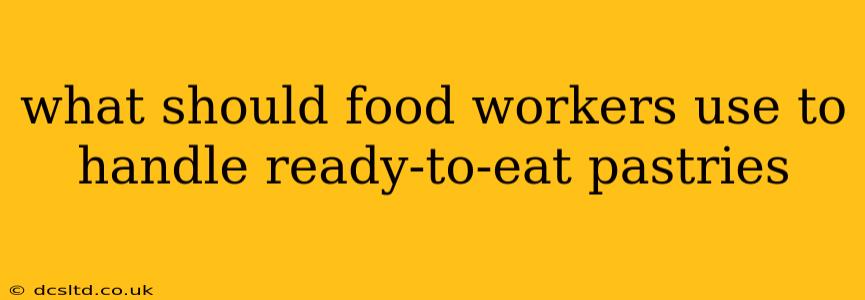Maintaining food safety is paramount when handling ready-to-eat pastries. Improper handling can lead to contamination and foodborne illnesses. So, what's the best way to ensure safe handling procedures? The answer is simple: clean hands and appropriate utensils. Let's delve deeper into the specifics.
What are Ready-to-Eat Pastries?
Before we discuss handling procedures, it's important to define what constitutes a ready-to-eat pastry. These are items that require no further cooking or preparation before consumption. Examples include:
- Cakes
- Cookies
- Pies
- Doughnuts
- Muffins
- Croissants
- Danishes
Why Proper Handling is Crucial for Ready-to-Eat Pastries
Ready-to-eat foods are particularly vulnerable to contamination because they're eaten without any further cooking steps to kill harmful bacteria. Bacteria like Salmonella, E. coli, and Listeria can cause serious illness, even from a small amount of contamination. This makes safe handling practices absolutely essential.
What Tools Should Food Workers Use to Handle Ready-to-Eat Pastries?
Food workers should always use clean utensils when handling ready-to-eat pastries. This prevents the transfer of germs from hands to food. Acceptable tools include:
- Clean tongs: Ideal for grabbing and moving pastries without direct hand contact.
- Clean spatulas: Useful for serving or transferring pastries from containers.
- Clean gloves: Disposable gloves offer a barrier between hands and food, but they're not a substitute for proper handwashing. Gloves should be changed frequently and discarded properly.
- Paper or parchment paper: Can be used to line serving trays or to individually wrap pastries.
How Often Should Food Workers Wash Their Hands?
Handwashing is the most critical aspect of preventing contamination. Food workers should wash their hands thoroughly:
- Before starting work: This removes any germs accumulated before entering the food preparation area.
- After handling raw food: Crucial to prevent cross-contamination from raw ingredients to ready-to-eat items.
- After using the restroom: Essential to avoid transferring pathogens from the restroom to the food.
- After touching any potentially contaminated surface: This includes hair, face, or other non-food related items.
- After sneezing or coughing: To prevent the spread of respiratory droplets.
- Between handling different food items: Prevents cross-contamination.
- Before putting on gloves: Clean hands are essential for the effectiveness of gloves.
What are the Proper Handwashing Procedures?
Proper handwashing involves more than a quick rinse. Follow these steps:
- Wet hands with warm water.
- Apply soap.
- Rub hands together vigorously for at least 20 seconds, covering all surfaces.
- Rinse thoroughly under warm running water.
- Dry hands with a clean towel or air dryer.
Are There Any Specific Regulations Regarding Pastry Handling?
Food safety regulations vary by location, but all jurisdictions emphasize the importance of proper hygiene and handling procedures to prevent contamination of ready-to-eat foods. Check with your local health department for specific guidelines in your area.
Can I Use Bare Hands to Handle Ready-to-Eat Pastries?
While some might argue it's acceptable under specific, strictly controlled and extremely sanitary conditions, generally it is not recommended to use bare hands to handle ready-to-eat pastries in a food service environment. The risk of contamination is simply too high. Utensils and gloves are always the safer and more hygienic options.
By consistently employing these safe handling practices, food workers can significantly reduce the risk of contamination and ensure the safety of ready-to-eat pastries for consumers. Remember, prevention is always the best strategy when it comes to food safety.
